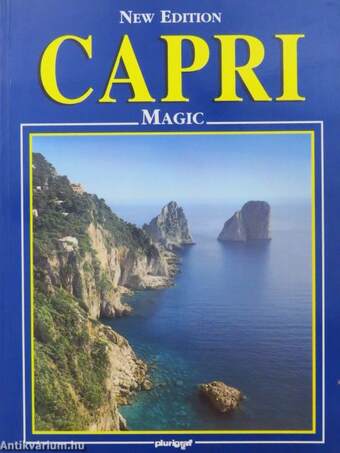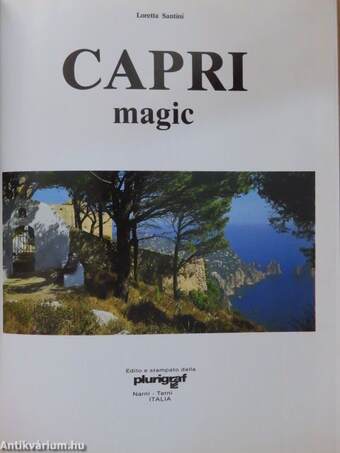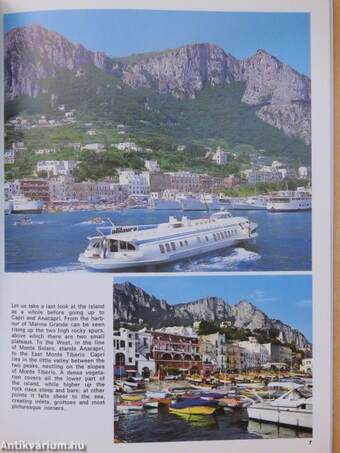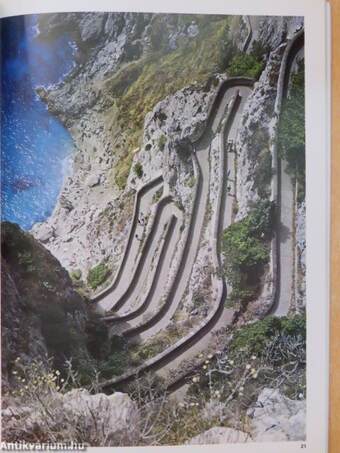1.076.445
kiadvánnyal nyújtjuk Magyarország legnagyobb antikvár könyv-kínálatát

VISSZA
A TETEJÉRE
JAVASLATOKÉszre-
vételek
Capri
Magic/New Edition
| Kiadó: | Casa Editrice Plurigraf |
|---|---|
| Kiadás helye: | Narni-Terni |
| Kiadás éve: | |
| Kötés típusa: | Fűzött papírkötés |
| Oldalszám: | 63 oldal |
| Sorozatcím: | plurigraf |
| Kötetszám: | |
| Nyelv: | Angol |
| Méret: | 27 cm x 20 cm |
| ISBN: | 88-7280-128-1 |
| Megjegyzés: | Színes fotókkal. |
naponta értesítjük a beérkező friss
kiadványokról
naponta értesítjük a beérkező friss
kiadványokról
Előszó
CAPRI
The island of Capri, a geographical prolongation of the Sorrento Peninsula, closes the Bay of Naples to the South, just as the island of Ischia, to the North, gave a foretaste of the... Tovább
Előszó
CAPRI
The island of Capri, a geographical prolongation of the Sorrento Peninsula, closes the Bay of Naples to the South, just as the island of Ischia, to the North, gave a foretaste of the beauties of this part of Italy. Thus Capri embraces the marvels of this stretch of coast and faces the no less picturesque landscape of the Bay of Salerno. It is a small island, covering barely 10 square Km., and is roughly quadrangular in shape. One is immediately struck by the cliffs rising sheer out of the sea, the luxurious vegetation covering most of the island, and the dazzling white houses scattered among the green.
The little town of Capri is the main centre. To the West of it stands Anacapri, on a high plateau on the slopes of Monte Solaro. Most of the inhabitants live in these two places. The fishermen's families for the most part live at Marina Grande, which is also the island's main port, while Marina Piccola, situated on the South coast, is a very popular little resort with a marvellous position.
Naturally, tourism is the main business of the island's inhabitants, but some of the people are engaged in fishing and the cultivation of olives and the vine. The island's flora and fauna (especially as regards fish), are particularly interesting and varied. The flora above all, thanks to the large number of species it offers, is a valuable asset to the island, forming part of its many beauties.
To list the beauties that have made Capri famous throughout the world, would only mean making a dry enumeration without being able to catch its spirit. Capri is a jewel box full of marvels, and this is due above all to Nature. The Blue Grotto, the Faraglioni, the Natural Arch, the countless other grottoes scattered along its coast and the steep cliffs falling sheer into the sea, are only a few of its best known features. In addition, there are the magnificent views, the picturesque depths with the crystal clear water, the many parks and public gardens, the characteristic architecture of the houses, and the local colour that can be noted in the buildings and the products of handicraft. Nor should one overlook the interesting remains of Roman times, such as those of the splendid Villa Jovis, or the Villa Damecuta, and the beautiful Villa San Michele dating from the early years of this century.
Capri has been rightly called the Pearl of the Sea: to know it means to rediscover the creative force of Nature and the sense of its beauty. Vissza
Témakörök
- Idegennyelv > Idegennyelvű könyvek > Angol > Művészetek > Fotóművészet
- Idegennyelv > Idegennyelvű könyvek > Angol > Útikönyvek
- Útikönyvek > Európa > Dél-Európa > Egyéb
- Útikönyvek > Idegennyelvű útikönyvek > Angol
- Útikönyvek > Utazás, turizmus
- Útikönyvek > Természetjárás, túrák > Egyéb
- Művészetek > Fotóművészet > Albumok > Tematikus
- Művészetek > Fotóművészet > Idegen nyelv > Angol
- Művészetek > Fotóművészet > Témái > Egyéb















